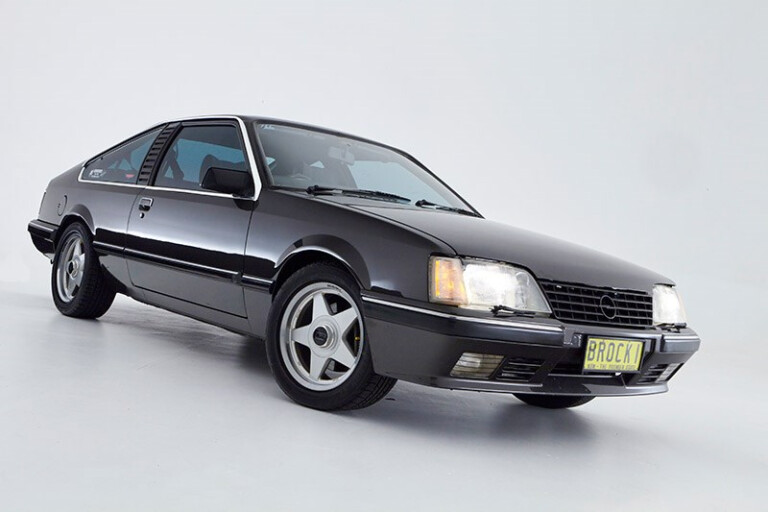
This article was originally published in the March 2004 issue of Street Machine magazine
DON’T you hate it when car companies show off sexy new models at motor shows with the promise to build production versions, only to have them fall off the radar, never to be seen again? Apart from Holden’s new Monaro, itself a concept car shown at the Sydney Motor Show in 1998, most show cars are never considered for production, despite the vague promises made by car companies.
These one-offs are often used either as ‘image builders’ or simply just to get you to visit their show stands and look over their regular production models. Of course, sometimes the intention to build is genuine, but warranty woes, jumpy bean counters and even government intervention gets in the way and squashes our hopes and dreams.
The upside to all this is the inspiration they provide. Most of the cars on this list are eminently buildable, particularly those with commonly available Aussie body styles, such as the V8 Torana GTR XU-1, Phase IV GTHO Falcon and E55 Charger. Getting the HRT 427 look would be fairly simple, but the wishbone front suspension might be a challenge! Building an XT Superoo or HDT Monza replica from an imported left-hand-drive body would take some effort, but you’d finish up with a real eye-catcher! So here’s our pick of the cars that we was robbed of, and there’s enough variety to keep you wide awake all night.
XT FALCON GT SUPEROO COUPE
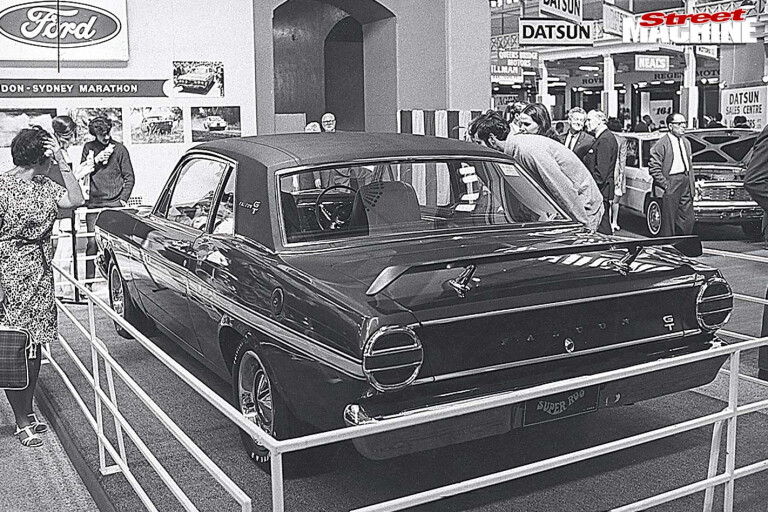
When the original Monaro was selling its tits off, Ford had nothing but four-doors so it conjured up a two-door Superoo Falcon GT and teased the public with it at the 1969 Melbourne Motor Show. It was built by newly-arrived Ford Motorsport boss, Al Turner, who based it on an American Falcon two-door coupe styled to look like an XT Falcon GT. It had 351 Windsor V8 mumbo under the bonnet, a shaker hood scoop, a boot-mounted rear wing, and XW GT stripes down the sides, complete with Superoo stickers. The 351 Windsor came in the XW GT later in 1969, the shaker and rear wing saw the light of day in the XY GT in 1971, but sadly the coupe didn’t make the cut.
BILL BOURKE’S 428 XW GT
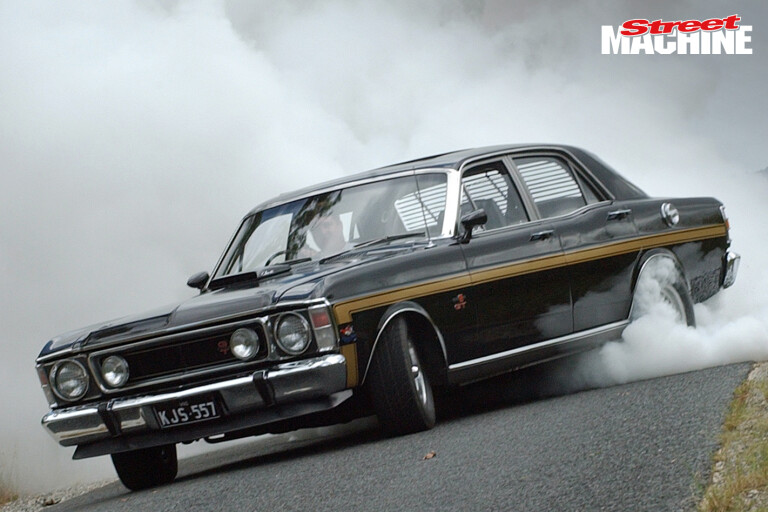
American Bill Bourke was like a dynamic breath of fresh air when he landed at Ford in the mid-1960s. He wanted to build an Australian Mustang and he did, in the form of the Falcon GT. But Bourke wanted more for his own transport so he had Al Turner and the Ford race team stuff a 428-cube Cobra Jet V8 under the hood of an XW GT, complete with a shaker scoop poking through the bonnet. It was painted black-gold and came fully optioned with a T-bar auto, sunroof, air con, taped sound, power steering, air horns, leather steering wheel, and XY-type bonnet locks. Just the one car was built.
FALCON GTHO PHASE IV
.jpg)
Another victim of the Supercar scare, the Phase IV was the final stanza of the most exciting period in Ford Australia’s history – until now!
The Phase IV was supposed to be the HO burger with the lot. It was based on the new XA Falcon, but the engine and trans were much the same as the XY Phase III, apart from a winged sump designed to cure the Cleveland V8’s oiling problem. In June 1972, Sydney’s Sunday Sun-Herald broke the story on the 160mph ‘Supercars’, which put the frighteners on Ford, Holden and Chrysler who all feared a government backlash, and shortly after they all killed their planned 1972 Bathurst specials. Three Phase IV race cars were built, then sold off after the program was scrapped, and one Phase IV was built in production.
V8 TORANA XU-1

Built to take on the Phase IV, the V8 XU-1 was killed off by government pressure (XU-2 replica pictured)
The screaming newspaper headline of June 1972 put paid to many more great Aussie muscle cars, as well as others that were being prepared for Bathurst that year. One was Holden’s V8-powered LJ Torana which was to replace the XU-1. The V8 XU-1 had a Holden 308ci V8 in a package that looked pretty much like a six cylinder XU-1. Two prototypes were completed and a third was underway, when the top brass in the General’s bunker pulled the pin on the whole project. One of the two completed cars was rebuilt as a stock XU-1, the other was used as a transport hack around Holden’s Lang Lang Proving Ground before eventually being destroyed in a crash-barrier test.
CHARGER E55

Chrysler did release an E55 (pictured) but it was a shadow of what the car should have been
Chrysler was preparing for an all-or-nothing assault on Bathurst in 1972, this time sacrificing six-pack power for a stonking hot V8. Codenamed E55, it would have been the biggest and baddest Charger of ’em all. With 340 cubes under the hood, a four-slotter in the tunnel and a tough Dana in the rear, the E55 would have been hard to beat in 1972, but it never got the chance. The bits that arrived for the run of production cars required to qualify the car for Bathurst went into the milder E55 that was eventually built. Chrysler people deny the existence of a Bathurst V8, but why would they fit a four-bolt mains V8 into a road cruiser? And why would they import a container load of Dana locker diffs if they weren’t for racing?
LEYLAND P76 FORCE 7V
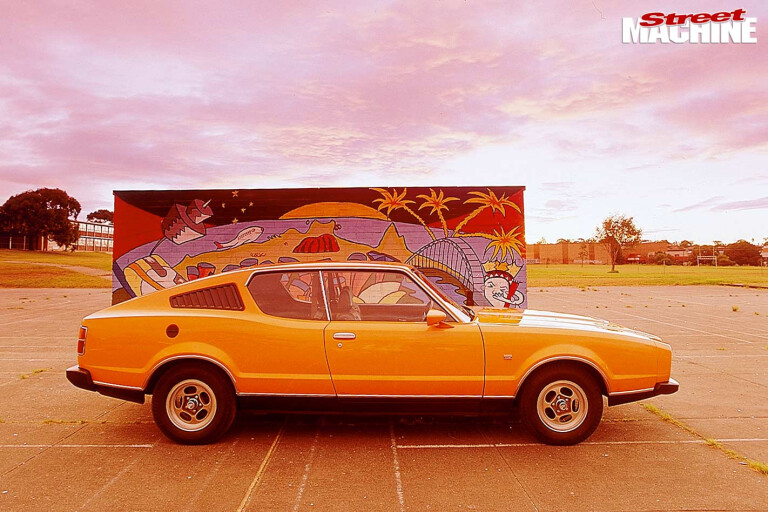
When Leyland took on the big three in the 70s, everyone else had a coupe, so the Brits built the Force 7
The hot coupe version of the Leyland P76 got closer to production than most. Had it not been for the 1974 failure of Leyland Australia, the Force 7V would have been a road-going reality, even a potential Bathurst winner. Designed by Italian stylist Michelotti, the Force 7V two-door coupe used the same mechanical package as the P76 sedan, including the 4.4-litre stretched version of the 3.5-litre Rover alloy V8. All except 10 Force 7V coupes were crushed when Leyland closed its doors. So close yet so far.
HX GTS TURBO
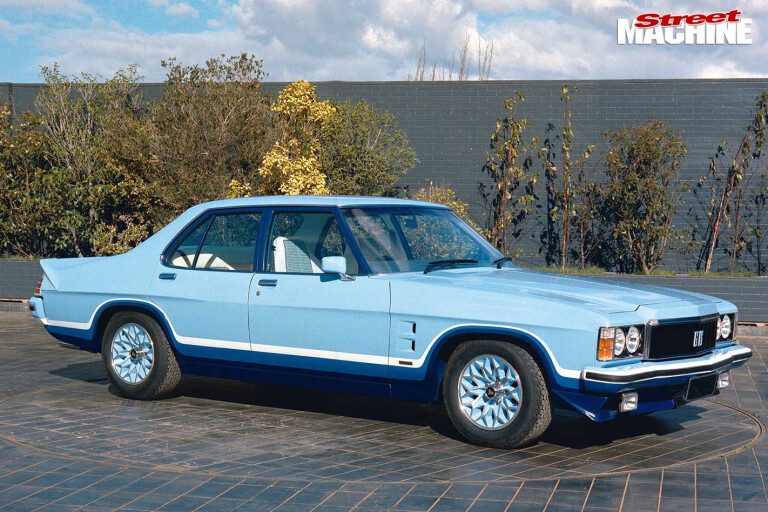
Like the sound of a 360hp, puffer fed GTS?
From the outside there was little to separate the baby-blue HX four-door GTS that appeared at the 1977 Melbourne Motor Show from regular production GTS sedans. Although it had a schmick, custom paint job by Holden’s styling boss Leo Pruneau, some ‘honeycomb’ wheels from a Pontiac Firebird, you had to look under the bonnet to unlock its secrets. There you found a 308 Holden V8 fitted with a NormalAir Garrett turbocharger that pumped power up to around 360 horsepower. It had heaps of mid-range torque, with a peak of 450ft/lb. On song, it was good for a low-15s pass. After doing the 1977 show circuit it was used by Holden boss John Bagshaw as his personal transport.
AAT FALCON
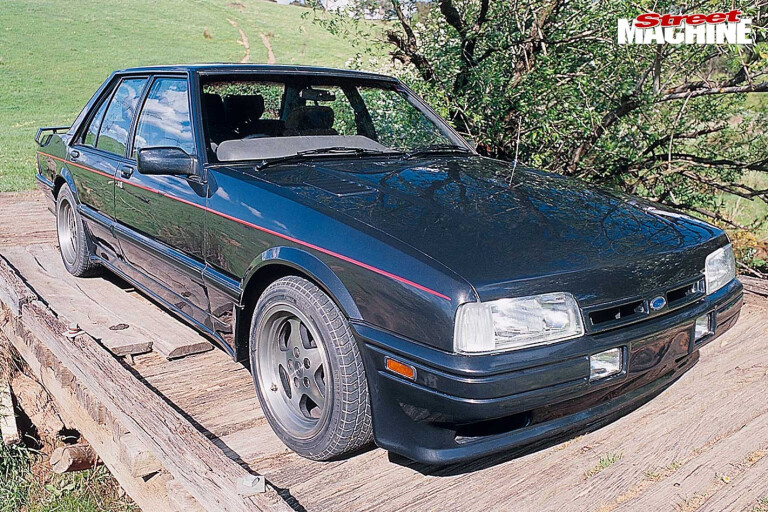
How do you like these apples? A 4WD XF Falcon with massive four-piston brakes and an intercooled twin-turbo EFI six! Could have been a monster to rival Godzilla
HSV’s Coupe 4 has got us all excited – lots of Aussie grunt delivered to all four wheels. Sounds like a bunch of fun, but it’s not the first time the concept has been attempted. Advanced Automotive Technologies had plans to sell an all-wheel-drive XF Falcon with a twin-turbo six under the bonnet!
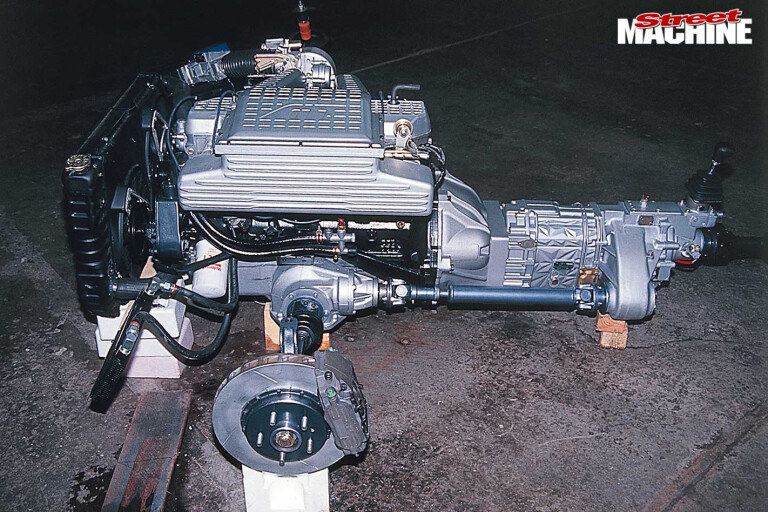
The donk was good for 268kW and a massive 500Nm at just 3000rpm. They built a prototype, too, which was good for 0-100km/h times in the mid sixes, and mid 14s over the quarter. Test drives at the time were favourable, but no more AAT Falcons were produced, so we never got to see if anyone would have actually paid the projected asking price of $75,000 for an XF Falcon. Like the SVO, the arrival of the EA was the final nail in the coffin of a sensational idea.
TURBO AND SVO FALCON
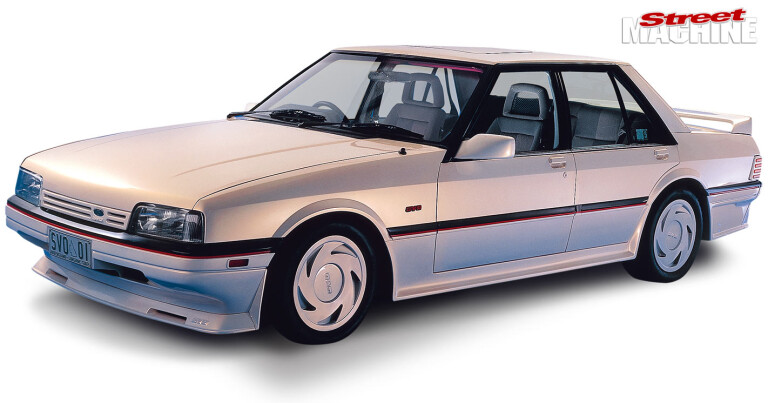
DJ tried a turbo, then built the SVO, a car which forshadowed the successful XR6 to come
When Ford axed its Aussie V8 in 1982, the Blue Oval’s domestic line-up was looking decidedly unexciting. The one bright light in the future was the possibility of a turbocharged Falcon six, a project driven by Ford’s race ace Dick Johnson. Dick worked with renowned Japanese tuning house HKS (“Clever little buggers, those Japs,” Dick was quoted as saying at the time) to produce a low boost kit for the EFI six that raised the power level to 166kW. The project came frighteningly close to being green lit – only to be pulled by Ford at the 11th hour due to warranty concerns. Not to be put off, Dick went back to the drawing board and came up with the SVO Falcon, to be built in partnership with Ross Palmer. Powered by a 150kW normally-aspirated six, the prototype ran a stylish bodykit, 16in rims, Recaro seats and a pearl paint job. The SVO got our pulses racing again, but with the spectre of the EA Falcon bearing down upon it, the project was canned.
BROCK MONZA

Years before the new Monaro, Brock imported an Opel Monza and built his own!
Peter Brock spotted a tape drawing of a two-door Commodore coupe during a visit to Holden’s styling boss Leo Pruneau in the early 1980s. Pruneau told him the drawing was a proposal for a Monaro version of the Commodore, based on the Opel Monza two-door coupe. Pruneau’s plan was to graft Commodore front-end sheet metal to the Monza body, and then fit the regular Holden power train package. His bosses weren’t convinced, but Brock saw the potential of a reborn Monaro and picked up Pruneau’s idea. He had Opel build a rolling chassis, including the Opel’s IRS and four-wheel disc brakes, on the German production line, then brought it to Australia and built it up to HDT Group 3 specs with a worked 5.0-litre Holden V8. The Monza coupe shown at the Melbourne Motor Show in 1984 was the only car built. The cost of making it comply with ADRs was considered too high.
AU FALCON COUPE

Desperate to match Holden’s show car cred, Ford borrowed the Hillier’s AU coupe to build the 300+
In a spooky re-run of the Superoo Falcon GT marketing ploy of 1969, the gorgeous AU Falcon coupe bobbed up on the Ford stand at the Melbourne Motor Show in 2001. Ford said it was looking at the possibility of a joint venture with Advanced Engine Components, the Perth-based makers of Sprintex superchargers who developed the coupe’s 300-plus-kW supercharged 4.6-litre DOHC Mustang V8, and their design partner, Millard Design, who updated the coupe’s body that was originally built by the Hillier brothers. This could have been the perfect foil for Holden’s Monaro and Ford fans salivated at the thought. Unfortunately, like the original Superoo coupe, it was more smoke and mirrors from Ford who just wanted a car to attract visitors to their stand and look at the boring Falcon line-up while Holden was getting all the attention with its new – and available – Monaro.
HRT 427
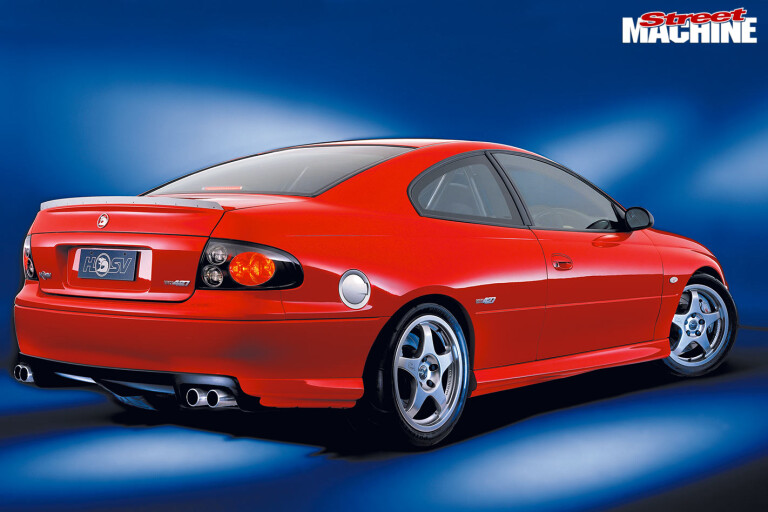
No comprimises – 7.0-litre V8 donk, mega brakes and re-engineered suspension
Touted as the hottest car ever produced in this country, the HRT 427 coupe combined the slinky Monaro two-door body with some very serious mumbo courtesy of a 427-cube, 420kW Gen III Corvette V8, T56 six-speed trans and AP racing stoppers to form a supercar with the performance to beat the world’s best. The red rager had carbon-fibre body panels, magnesium diff housing, wishbone front suspension and a full race interior including a roll cage. The hot HSV coupe was born to run with the impressive figures of four seconds to 100km/h, low 11s for the 400 metre sprint, top-end better than 300km/h according to those in the know. Despite a long list of admirers who actually made a down payment on the $215,000 needed to acquire one of the 50 cars proposed for production, HSV claimed it was too costly to make it meet ADR requirements.
RECARO MYSTERE

Never seen a Torana like this one, eh? With a little work, it could still look trick in 2004
Designed by Peter Arcadipane – the same dude who nutted out the Concorde van that was the basis of the Mad Max coupes – the Mystere was intended to be a sophisticated Euro-style sports hatch based on the LX Torana. Built by Recaro, the Mystere scored enough publicity to pay for the cost of the prototype, but production was also seriously looked at. With its boxed guards, stumpy tail and swoopy bonnet line, the Mystere looked like nothing else on Aussie roads back in 1978. Underneath, it was pretty much a stock LX SS 5-litre with uprated suspension and big rims. The inside was pretty flash though, with power windows, air conditioning and top-notch Recaro seats.
HOLDEN GTR-X

Of all the cars on the list, the beautiful GTR-X was the one that almost made it to reality
Believe it or not, the GTR-X was a serious attempt by Holden to build a sports car. Based on a ladder chassis with a gorgeous fibreglass body wrapped around an XU-1 Torana mechanical package, the GTR-X first saw the light of day as a show car in 1970. Overwhelming public reaction encouraged Holden to press on with the project. Three prototypes were built and production only needed final approval from the GM bosses in Detroit. Holden’s management got cold feet at the last moment and canned the project in 1971. Holden still has the prototype show car which was recently restored.

COMMENTS